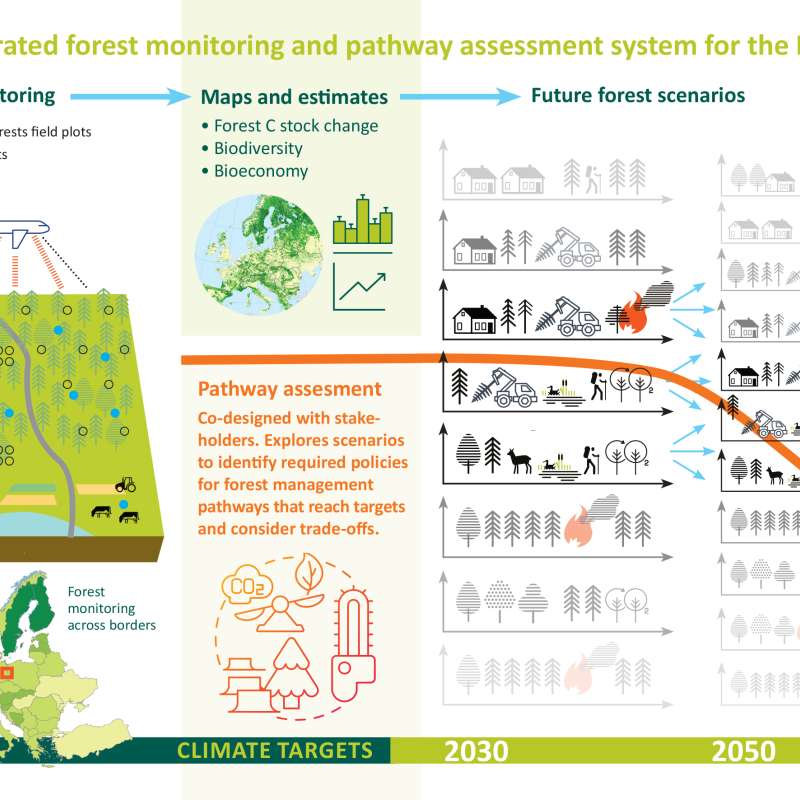Clara Antón Fernández
Senior Research Scientist
(+47) 482 15 794
clara.anton.fernandez@nibio.no
Place
Ås H8
Visiting address
Høgskoleveien 8, 1433 Ås
Authors
Jari Hynynen Narayanan Subramanian Clara Antón Fernández Soili Haikarainen Emma Holmström Micky Allen Saija Huuskonen Jouni Siipilehto Hannu Salminen Mika Lehtonen Kjell Andreassen Urban NilssonAbstract
No abstract has been registered
Authors
Iris Hordijk Lourens Poorter Jingjing Liang Peter B. Reich Sergio de-Miguel Gert-Jan Nabuurs Javier G. P. Gamarra Han Y. H. Chen Mo Zhou Susan K. Wiser Hans Pretzsch Alain Paquette Nicolas Picard Bruno Hérault Jean-Francois Bastin Giorgio Alberti Meinrad Abegg Yves C. Adou Yao Angelica M. Almeyda Zambrano Braulio V. Alvarado Esteban Alvarez-Davila Patricia Alvarez-Loayza Luciana F. Alves Iêda Amaral Christian Ammer Clara Antón Fernández Alejandro Araujo-Murakami Luzmila Arroyo Valerio Avitabile Gerardo A. Aymard C Timothy Baker Olaf Banki Jorcely Barroso Meredith L. Bastian Luca Birigazzi Philippe Birnbaum Robert Bitariho Pascal Boeckx Frans Bongers Olivier Bouriaud Pedro H. S. Brancalion Susanne Brandl Francis Q. Brearley Roel Brienen Eben N. Broadbent Helge Bruelheide Roberto Cazzolla Gatti Ricardo G. Cesar Goran Cesljar Robin L. Chazdon Chelsea Chisholm Emil Cienciala Connie J. Clark David B. Clark Gabriel Colletta David Coomes Fernando Cornejo Valverde Jose J. Corral-Rivas Philip Crim Jonathan Cumming Selvadurai Dayanandan André L. de Gasper Mathieu Decuyper Géraldine Derroire Ben DeVries Ilija Djordjevic Aurélie Dourdain Jiri Dolezal Nestor Laurier Engone Obiang Brian Enquist Teresa Eyre Adandé Belarmain Fandohan Tom M. Fayle Leandro V. Ferreira Ted R. Feldpausch Leena Finér Markus Fischer Christine Fletcher Lorenzo Frizzera Damiano Gianelle Henry B. Glick David Harris Andrew Hector Andreas Hemp John Herbohn Annika Hillers Eurídice N. Honorio Coronado Cang Hui Hyunkook Cho Thomas Ibanez Ilbin Jung Nobuo Imai Andrzej M. Jagodzinski Bogdan Jaroszewicz Vivian Johannsen Carlos A. Joly Tommaso Jucker Viktor Karminov Kuswata Kartawinata Elizabeth Kearsley David Kenfack Deborah Kennard Sebastian Kepfer-Rojas Gunnar Keppel Mohammed Latif Khan Timothy Killeen Hyun Seok Kim Kanehiro Kitayama Michael Köhl Henn Korjus Florian Kraxner Diana Laarmann Mait Lang Simon Lewis Huicui Lu Natalia Lukina Brian Maitner Yadvinder Malhi Eric Marcon Beatriz Schwantes Marimon Ben Hur Marimon-Junior Andrew Robert Marshall Emanuel Martin Olga Martynenko Jorge A. Meave Omar Melo-Cruz Casimiro Mendoza Cory Merow Stanislaw Miscicki Abel Monteagudo Mendoza Vanessa Moreno Sharif A. Mukul Philip Mundhenk Maria G. Nava-Miranda David Neill Victor Neldner Radovan Nevenic Michael Ngugi Pascal A. Niklaus Jacek Oleksyn Petr Ontikov Edgar Ortiz-Malavasi Yude Pan Alexander Parada-Gutierrez Elena Parfenova Minjee Park Marc Parren Narayanaswamy Parthasarathy Pablo L. Peri Sebastian Pfautsch Oliver L. Phillips Maria Teresa Piedade Daniel Piotto Nigel C. A. Pitman Martina Pollastrini Irina Polo Axel Dalberg Poulsen John R. Poulsen Freddy Ramirez Arevalo Zorayda Restrepo-Correa Mirco Rodeghiero Samir Rolim Anand Roopsind Francesco Rovero Ervan Rutishauser Purabi Saikia Christian Salas-Eljatib Peter Schall Dmitry Schepaschenko Michael Scherer-Lorenzen Bernhard Schmid Jochen Schöngart Eric B. Searle Vladimír Seben Federico Selvi Josep M. Serra-Diaz Douglas Sheil Anatoly Shvidenko Javier Silva-Espejo Marcos Silveira James Singh Plinio Sist Ferry Slik Bonaventure Sonké Alexandre F. Souza Hans ter Steege Krzysztof Stereńczak Jens-Christian Svenning Miroslav Svoboda Ben Swanepoel Natalia Targhetta Nadja Tchebakova Raquel Thomas Elena Tikhonova Peter Umunay Vladimir Usoltsev Renato Valencia Fernando Valladares Fons van der Plas Tran Van Do Michael E. Van Nuland Rodolfo Vasquez Martinez Hans Verbeeck Helder Viana Alexander C. Vibrans Simone Vieira Klaus von Gadow Hua-Feng Wang James Watson Gijsbert D. A. Werner Florian Wittmann Verginia Wortel Roderick Zagt Tomasz Zawila-Niedzwiecki Chunyu Zhang Xiuhai Zhao Zhi-Xin Zhu Irie Casimir Zo-Bi Daniel S. Maynard Thomas W. CrowtherAbstract
No abstract has been registered
Abstract
Intensification of forest management is seen as one important measure to increase carbon sequestration and contribute to balance CO2 emissions and mitigate climate change. Potential measures for forest management intensification include increasing the percentage of the area that is actively reforested after felling, planting at higher densities and with genetically improved material, nitrogen fertilization, and pre-commercial thinning. Here we assessed the mitigation potential of these practices in Norwegian forests from 2018 until the end of the 21st century. As a result, when these management practices were intensified, separately and simultaneously, carbon sequestration over the 80-year simulation period was larger than under current practices. Pre-commercial thinning gave the largest additional 80-year carbon dioxide removal increment and fertilization the smallest. The largest accumulated carbon dioxide removal potential occurred when intensifying all the proposed measures in one scenario and was estimated to be around 329.9 Tg CO2 by the end of the century, corresponding to offset more than six times Norway's total GHG emissions in 2022. If the intensification of these practices is considered separately, our results suggested that pre-commercial thinning and active reforestation after felling, in that order, should be prioritized as climate change mitigation measures, followed by genetic improvement, planting density and fertilization.

